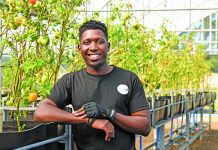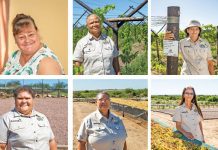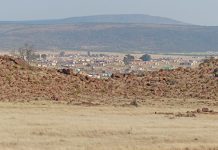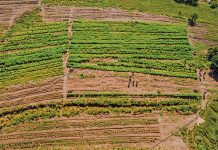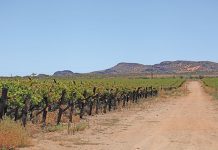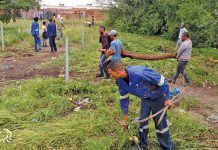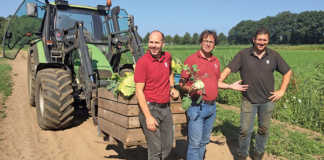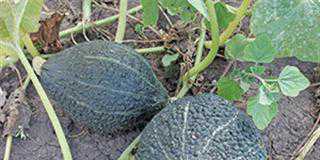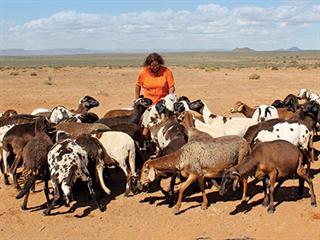
The neat, green fruit orchards blanketing much of the Ceres Valley come to an abrupt end near the Theronsberg Pass. Soon the land of rain and fertile soils is far away as the landscape unfolds to offer the stark simplicity of the Ceres Karoo. The only movement between the road and the horizon is a pair of whirlwinds moving across the veld. It was exactly this sense of peace and isolation that appealed to Carole Kirkwood Pretorius when she first visited the area seven years ago looking for a farm to buy.
Having grown up in the city, she needed a change of scenery and lifestyle after a particularly brutal and traumatising attack. “I knew nothing about farming, but I wanted to get away from people to rather work with animals. I came to the Karoo to become whole again,” she recalls. In 2007, after buying the 1 360ha farm Avontuur and promptly renaming it Capre-Avontuur, Carole began small with a variety of animals: pigs, milk goats and Damara sheep.
“I started out just playing at being a farmer, but I’ve learnt a lot since then,” she admits. The farm was initially run down and unproductive, but her plan to turn it into a viable commercial unit has already yielded results, and Carole was named Smallholder Farmer of the Year at the 2013 Western Cape Female Entrepreneur of the Year Awards.
“I started out with 10 goats – Saanen, Toggenburg and Bunte Deutche Edelziege (BDE) – and now have about 44. The Damara flock grew from 20 ewes to 300. During the prolonged drought four years ago I had to decrease its size drastically, but I’m now back to 100 ewes and aim to grow to 300 again,” she says.
Carole also has 13 sows – Large White and Landrace – and two boars. To diversify her operation, she has started rearing broilers during the cooler months. “There was almost nothing on the farm when I bought it. All the buildings were dilapidated and had to be rebuilt,” she remembers. “We had to build stone barns and holding pens, put up fencing, sink boreholes and install solar panels.”
Eskom’s service does not reach all the way to the Ceres Karoo, and farmers have to be self-sufficient in terms of power supply.
Carol also attended several short courses on farming, but admits that most of her knowledge has been gained through trial and error. “I chose to farm Damara sheep because they are well adapted to our conditions,” she explains. “They have good resistance against parasites and don’t have to be shorn.”
Breeding
Ewes lamb three times in two years. Carole keeps lambs with their mothers for three days after birth, then removes and bottle-feeds them a mixture of goat milk and formula. Each lamb receives about 1,5l/ day. “We gradually introduce lucerne and oats hay into their diet,” she explains. “At six weeks, they start going out to the veld, but we still feed them. At eight weeks, they start living on the veld.
“The ewes are ready to breed again within six weeks of lambing.”
After a steep learning curve, Carole seems to have mastered hand-rearing and now has close to a 100% success rate. Most of the ewes are retained as breeding stock in the flock. Ram lambs not selected for breeding are marketed for slaughter at a liveweight of about 32kg.
To introduce genetic variation, Carole buys in new rams every two years. “I try to obtain the best genetics available,” she says. “This has helped to increase quality and fertility in the flock.” Carole’s flock has an average lambing rate of about 190% per year (there are three lambing seasons every two years).
The Damara can utilise the Karoo veld well and receive only supplementary feed when veld conditions are poor. To improve their condition, ewes receive ewe pellets and oats hay as supplementary feed from a month before lambing until three or four weeks afterwards. During this time, rams receive oats hay as well as a protein lick. It is not necessary to treat the sheep for ticks. To control internal parasites, Carole follows a dosage schedule prescribed by a veterinarian.
Important lessons learnt
“The two most important lessons I’ve learnt about farming are to obtain as much knowledge as possible before starting a venture and, when farming livestock, to buy in good genetics,” says Carole. “But it’s very hard work. I never expected it to require so much time and dedication just to break even.” Her advice to other new farmers is to start with a sufficient cash reserve. “You’ll spend a lot of money – more than you think – before you start earning any.”
A haven for those in need
Carole employs two workers who live on the farm. She has also turned the farm into a refuge for homeless job-seekers, recovering drug and alcohol addicts, and abused women. “I don’t turn anyone away who needs help,” she explains. Anyone who arrives looking for work is taken in for up to three days to enable them to feed themselves and their families. Carole then helps them to look for permanent employment. If unsuccessful, they may stay a few more days before continuing the search.
Various institutions refer recovering drug addicts and alcoholics to the farm for a short transition period. As soon as they are well enough, they start working on the farm as part of their rehabilitation. This, according to Carole, helps improve their sense of self-worth and mental and physical health, as well as earning them some income.
“I’ve learnt through experience that caring for animals can be a powerful tool that helps facilitate the healing process,” she says.
Phone Carole Kirkwood Pretorius on 073 310 1246 or email [email protected].

